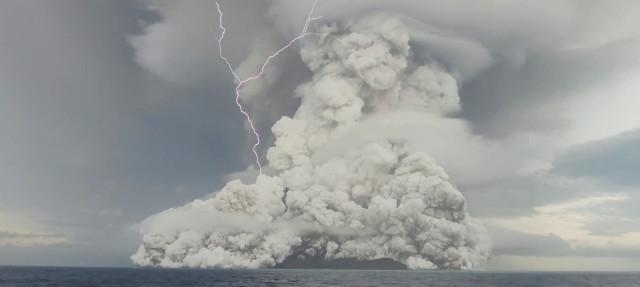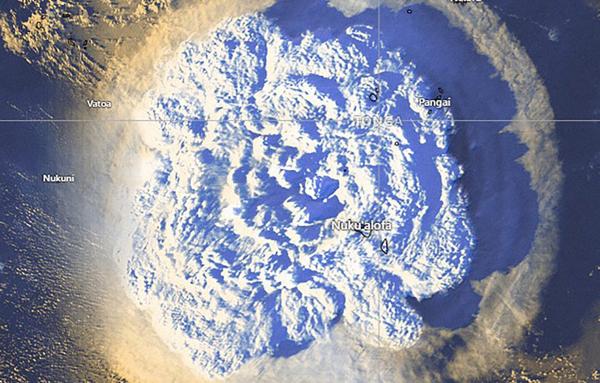- Scientists have never seen anything like it
Mysterious waves swept the Earth after the eruption of the volcano in Tonga. The concentric waves in the atmosphere stunned scientists. They have never seen anything like it, RIA Novosti reported.
Wave oscillations have been recorded both on the surface and high above the Earth in the ionosphere. The unique phenomenon was explained by gravitational waves, but everything turned out to be more complicated.
The volcano Hunga-Tonga-Hunga-Haapai off the coast of the island kingdom of Tonga woke up in December 2021, and a month later erupted powerfully. This caused earthquakes and tsunamis that reached the shores of Peru on the other side of the Pacific Ocean. A huge cloud of ash rose twenty kilometers into the stratosphere. The sound of the explosion was heard thousands of miles across the Yukon in Canada, and infrasound waves – below the threshold of human hearing – were recorded by specialized equipment around the world.
The eruption caused massive fluctuations in the atmosphere – the so-called atmospheric gravitational waves. They were discovered by NASA’s Aqua satellite a few hours later. His images show dozens of concentric circles, each representing a fast-moving wave.

Acoustic-gravitational waves (AGW) are well known to atmospheric physicists, but have never been so clearly recorded in volcanic eruptions. Strong AGWs are usually associated with earthquakes, tsunamis and some artificial events, such as rocket launches or explosions. Smaller waves occur due to various phenomena – movements of atmospheric fronts, thunderstorms, geomagnetic storms, solar flares, even diurnal fluctuations in the atmosphere.
“There is nothing unusual in these waves,” said Sergei Pulinets, chief researcher at the Institute for Space Research of the Russian Academy of Sciences, quoted by RIA Novosti. He explained that these were sound waves, but with very low vibrations. We hear them, like any sound, they appear during the contraction-expansion of the air, when they set in motion the atmospheric masses.
The eruptions of the volcano erupted around the globe several times, and barometers in different parts of the world recorded several small peaks – about 1.5 millibars – of increasing pressure.
In Seattle, on the west coast of the United States, the jump was so strong that it dispelled the traditional local fog, according to the local office of the National Weather Service. In Britain, about 16,500 kilometers from the Tongan islands, the first wave was caught 14 hours after the eruption, which determined its speed – about 330 meters per second. This roughly corresponds to the speed of sound. Subsequent waves were recorded by particularly sensitive barometers for another day.
The initial wave was felt all over the world. It is registered by all 53 stations of the Infrasound Monitoring System of the Comprehensive Nuclear-Test-Ban Treaty located 1800 to 18,000 kilometers from the volcano. For comparison: the atmospheric waves from the meteorite in Chelyabinsk, which shook the Earth in 2013, were captured by only half of the network’s points.

Theoretically, the rapid upward flow of hot air and ash from an erupting volcano in the upper atmosphere could cause larger-scale acoustic gravitational waves. But what scientists observed after the Hunga-Tonga-Hunga-Haapai eruption did not fit into the scheme in terms of both scale and model. In the photos, the oscillations looked like a mixture of waves of different types and sizes.
“The peculiarity is that this is an underwater eruption,” said Sergei Pulinets. it’s an isolated island in the middle of the ocean, a circular wave, not reflected as in a coastal eruption. “
The explosive speed of the eruption was also unusual. Volcanoes usually pour lava and eject it for days and sometimes weeks. Here everything happened in a matter of minutes – as a result of a strong impulse. NASA experts have estimated the strength of the Hunga-Tonga-Hunga-Haapai eruption at ten megatons in TNT equivalent. This is 500 times stronger than the explosion of the atomic bomb dropped on Hiroshima.
The colossal detonation, as well as the underwater collapse and the associated tsunami, generated a whole spectrum of waves propagating in both the lower and upper layers of the atmosphere. Apart from acoustic-gravitational – infrasonic, Lamb waves and electromagnetic oscillations in the ionosphere were detected. This, according to scientists, is the uniqueness of the atmospheric events that led to the eruption.
Satellite images have captured waves similar to those of a stone thrown into a lake from where the ash plume pierced the lower atmosphere. The static discharges in it triggered a wave of volcanic lightning. The satellites recorded more than 60,000 strikes in fifteen minutes after the initial eruption of the volcano, which corresponds to almost 70 lightning strikes per second. Then an atmospheric shock wave began to deviate in all directions from the plume, which provoked a jump in atmospheric pressure. Using NASA’s GOES-West satellite available online, Matthew Barlow, a professor of environmental, terrestrial and atmospheric sciences at Lowell University in Massachusetts, built a composite image of the motion of the original wave through the Earth’s atmosphere.
The sequence of events looks like this: the shock wave generates a high-frequency acoustic wave, which after a while turns into a low-frequency, and then into infrasonic. In the upper atmosphere, where gases are ionized, splitting into charged particles – ions and electrons – waves already cause electromagnetic oscillations. Using data from several terrestrial and space sensors, British physicist Catherine Mitchell of the University of Bath has made a video. It shows how ionospheric waves propagate from the volcano to New Zealand within hours of the eruption. They are seen as a change in the positive and negative deviations of the total electron content. According to experts from the American Geophysical Union, it took five hours on the waves to reach the shores of the United States.
Scientists are constantly monitoring with satellite observations the electromagnetic waves propagating in the ionosphere – an area of the atmosphere in the range of 60 to 1000 kilometers above the earth’s surface. In this area (about 400 kilometers above the Earth) rotates the manned orbital station of the ISS. For her and other spacecraft, ionospheric disturbances do not pose a danger. But they are capable of affecting the operation of satellite navigation systems such as GPS or GLONASS. The satellites themselves are located much further – from 20 to 26 thousand kilometers above the Earth, but their signal may deviate, falling into the ionosphere.
“The satellite wave reaches the Earth with a certain delay. Additional inhomogeneities in the ionosphere introduce errors in the expected signal delay, which reach tens of meters. Special services monitor and eliminate them – navigation errors can lead to accidents,” explains Pulinets. Surprisingly, seven days after the eruption, the acoustic-gravitational waves were still propagating after orbiting the globe for the tenth time. They are fixed in the infrared range by the geostationary satellites GOES-16 and GOES-17.
Tags:
–


